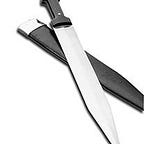4 REASONS WHY: THE RAPIER IS DIFFERENT FROM THE SABRE
Swords are a heavy dose of history, and quite often, they feel more baffling than intriguing. And as Museum Replicas (MRL) is now bringing to us many swords and rapiers for sale, we though it is the perfect time to set the record straight on the repeatedly misinterpreted weapons- rapiers and sabers.
What is a rapier?
The term ‘rapier’, a relatively newer coinage in the typology of swords, refers loosely to a straight, sharply pointed sword that is mostly double edged, which was in popular usage as a civilian sword from the 16th to 18th centuries, through the end of Renaissance. Sometimes, ‘rapier’ is used to denote the style of thrusting swordsmanship emphasized by these blades.
What is a sabre?
A sabre or a saber is a slightly curved and single edged sword, popularly used in infantry, and light cavalry or ‘Light Horse’, tracing back to as early as the 9th century. The reputation of sabre as a weapon peaked during the Early Modern and Napoleonic times, which ultimately led to the fruition of the discipline of modern sabre fencing in academic fencing.
Bit by bit, let us see the differences between these two emerge:
1. BLADE
The defining characteristic of a rapier’s blade is its sharply pointed tip. The blade has an even section throughout its enormous length and tapers towards the tip, which is designed with the correct mass to enable a good balance of robustness and agility. Quite often, the blade is sharpened near the hilt on both sides to prevent your opponent from taking hold of your weapon.
The sabre’s blade has a slight, gradual (sometimes deep) curve as its profile, and follows a ‘distal taper’ from its guard to the tip. The blade is one-edged, implying that we see a reduction in the blade’s thickness as we move from its spine to the sharpened edge.
2. HILT
A very pivotal part of both these weapons is the hilt or the haft.
A rapier is typically designed with a large hilt, allowing for your fingers to securely sit on its grip, and the index finger wrap over the quillon or the guard. The pommel has significant mass to counterpoise the weight of the blade and enable perfect wielding. These large hilts sometimes prove self-defeating as they restrict and damage your hands when your rival tries to disarm you.
The handle of a saber is designed in what is called a ‘back strap style’, varying in the level of detail, from simple to exclusively ornate. This hilt allows for several kinds of grips, including the classic ‘hammer grips’ and ‘thumb grips’.
3. DIMENSIONS
Like with every other sword, the variety of rapiers and sabers is colossal.
A rapier, on an average, weighs between 2.5 to 3.5 lbs., thanks to the substantial contribution form the pommel, and its blade measures between 42 and 45 inches.
A saber weighs less than or equal to 2.25 lbs., and its blade commonly measures around 32 inches. Hence, as you can observe, the sabre lightens towards the tip and is not as heavy as it looks.
4. ACTION
Clearly, the rapier is perfect for point thrust work with one hand. The handle allows for manipulation, and the blade, by virtue of its shape, leverages this for creating quick and painful thrusting actions through the tip, at long distances. If you learn to handle its weightiness and use the rapier wisely from safe distance, you can ‘just do it’ in one stroke, and escape swiftly after fruitfully landing your thrust(s).
But, for fighting in close quarters, and performing defensive and parry moves, you certainly need to carry with this a dagger or a smaller sword. This limitation explains why the rapier was primarily used as a self-defense or fashionable civilian sword, although smaller, more robust military versions existed. And yes, remember that their cutting power is not zilch; after all, an agile iron blade is intrinsically capable of a little amount of cutting action.
The saber, with its classic curved design, is excellent for all of the cutting actions. Enabling big swings and fast cuts, the saber is an incredible attacking weapon that can be used at a good range of distances from the handle. Hence, it comes as no surprise that sabers have the psychological effect of pushing the opponent into instant defense- as soon as you simply draw it out and swing it, one feels offended and intimidated. But, if you are thinking of thrusting with the saber, make sure your rival is not in possession of a rapier, since it stabs better anytime of the day.
These enjoyed acceptance majorly among the cavalrymen, who, using them as one-handed or two-handed swords (Swiss saber), dexterously utilized their lightness, high rotation speed, mobility with postures, and sharpened edge, for cutting and hurting the opponent.
FINAL VERDICT
The rapier is your ‘one-stop sword for thrusting actions’ that performs below average when you want to cut and slash.
The sabre, as quoted in The Italian manual of Marcelli, is ‘all-strong’, with superlative cutting capabilities.
